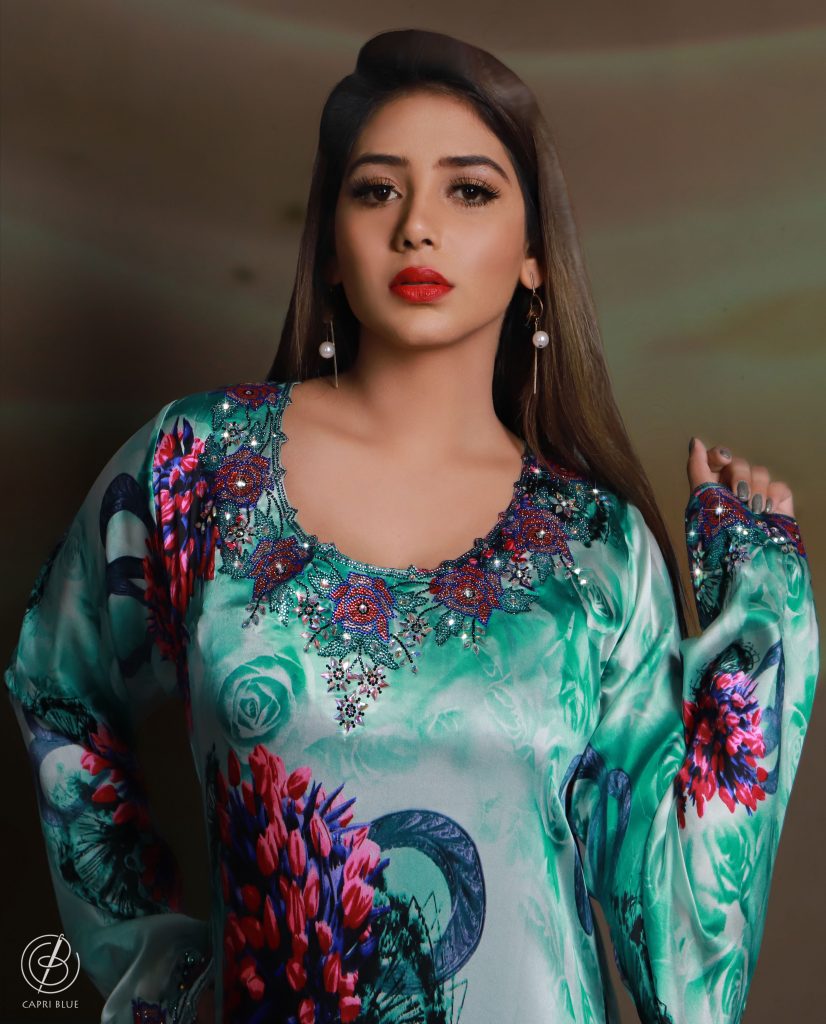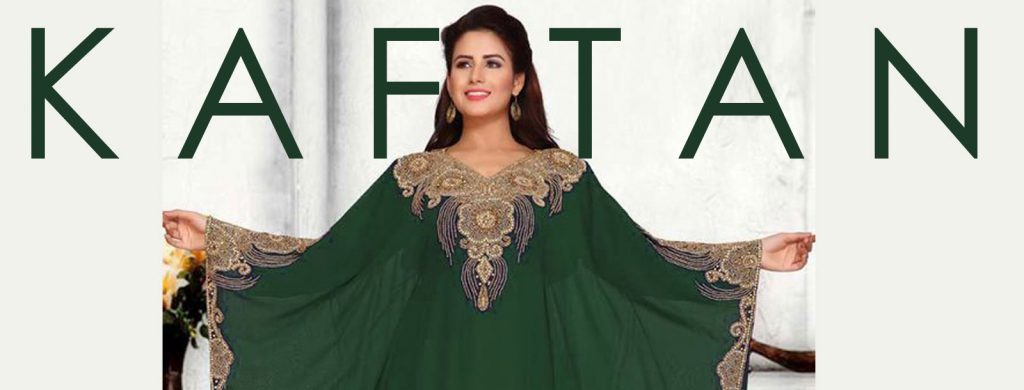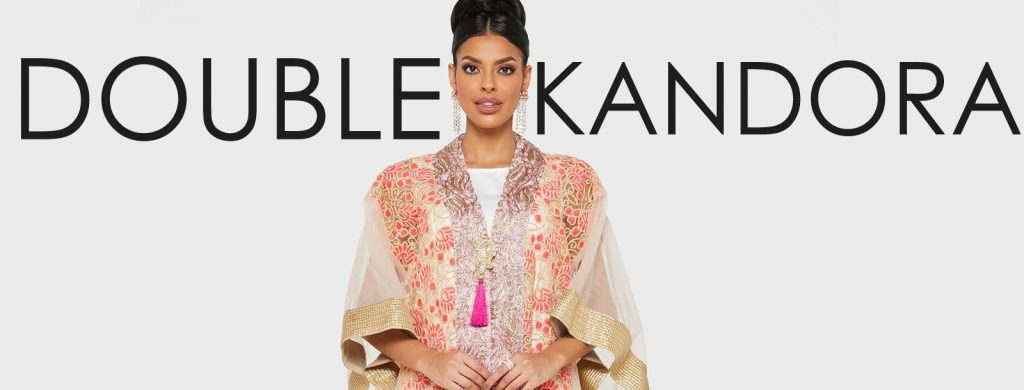Blogs

Elevating Elegance: The Timeless Charm of Tailored Arabic Clothes
Elevating Elegance: The Timeless Charm of Tailored Arabic Clothes
The rich and vibrant culture of the Arab world is beautifully reflected in its traditional clothing. From the flowing Kandoora to the graceful Jalabiya and the regal Kaftan, these garments embody elegance, heritage, and a sense of timeless charm. While off-the-rack options may be readily available, there is something truly special about opting for tailored Arabic clothes. Let us explore the allure and significance of these garments and the art of tailoring that brings them to life.
The Kandoora, also known as a dishdasha or thobe, holds a central place in the wardrobe of Arab women. This ankle-length garment is typically made from lightweight, breathable fabric, making it ideal for the region’s warm climate. Tailored Kandooras offer a personalized touch, ensuring a perfect fit that flatters the wearer’s physique. The expertise of skilled tailors brings out the intricate details, such as the delicate embroidery or embellishments that adorn the collar, cuffs, and front placket. The tailored Kandoora not only enhances the wearer’s appearance but also carries with it a sense of cultural pride and sophistication.
For Arab women, the Jalabiya and Kaftan are iconic choices that exude femininity and grace. The Jalabiya, a loose-fitting, floor-length dress, is often adorned with exquisite embroidery, lacework, or sequins. Tailoring brings out the true essence of the Jalabiya, ensuring that it accentuates the wearer’s figure while allowing for comfort and freedom of movement. The choice of fabric, color, and embellishments can be tailored to individual preferences, making each Jalabiya a unique piece of art that captures the wearer’s style and personality.
The Kaftan, on the other hand, is a regal and elegant garment that has transcended generations. Originally hailing from the Ottoman Empire, the Kaftan has become synonymous with luxury and sophistication. Tailored Kaftans showcase the skill of the artisans, with meticulous attention given to every detail. From the choice of sumptuous fabrics to the intricate embroidery, beadwork, and embellishments, each Kaftan is a masterpiece. By opting for a tailored Kaftan, women can revel in the joy of wearing a garment that not only fits perfectly but also showcases their unique taste and style.
What sets tailored Arabic clothes apart is the attention to detail and the customization options they offer. Skilled tailors, well-versed in the art of Arabic clothing, take into account the wearer’s preferences, body shape, and cultural nuances, resulting in a garment that is truly personalized. The choice of fabric is crucial, with considerations given to its quality, drape, and breathability. Embroidery, embellishments, and color combinations can be meticulously selected to align with the wearer’s vision, ensuring a garment that is a true reflection of their individuality.
In the UAE and other Arab countries, there are numerous tailoring services that specialize in Arabic clothing. These establishments boast experienced and talented tailors who possess a deep understanding of the cultural significance and nuances associated with these garments. They take pride in their craft, paying meticulous attention to every stitch, ensuring that each tailored piece meets the highest standards of quality and workmanship.
Tailored Arabic clothes have a timeless appeal that transcends fleeting fashion trends. They celebrate the rich heritage and cultural diversity of the Arab world, offering wearers a chance to embrace their roots and showcase their individual style. Whether it’s a traditional celebration, a formal event, or simply an expression of personal taste, tailored Arabic clothes provide a touch of luxury and sophistication that is hard to match.
So, next time you find yourself captivated by the allure of Arabic clothing, consider the beauty and exclusivity that tailored garments can bring. Step into a world of elegance, where skilled artisans and tailors transform fabric into wearable works of art. Embrace the enchantment of tailored Arabic clothes and experience the joy of wearing a garment that seamlessly blends tradition, style, and your unique essence.

The Jalabiya: An Exquisite Blend of Tradition and Contemporary Elegance
The Jalabiya, a flowing and graceful dress, has long been an iconic garment in Arab culture. This traditional attire, with its rich history and timeless allure, not only embodies the essence of Arab femininity but also serves as a canvas for creativity and self-expression. While the Jalabiya has deep roots in tradition, tailored versions of this dress have evolved to embrace contemporary influences, making it a versatile and exquisite choice for women across the Arab world and beyond.
Originating from the Middle East, the Jalabiya has a history that dates back centuries. Originally designed for practical purposes, it offered women comfort and modesty while reflecting the cultural values of the region. Traditionally, the Jalabiya features a loose, ankle-length silhouette with long sleeves, allowing for ease of movement and protection from the sun’s rays. Over time, it has become an integral part of Arab culture, symbolizing elegance, femininity, and a celebration of heritage.
Tailored Jalabiyas offer a unique opportunity to infuse personal style and individuality into this classic garment. Skilled artisans and tailors, well-versed in the art of Arabic clothing, meticulously craft each Jalabiya to the wearer’s specifications. From fabric selection to intricate details, every aspect of the tailored Jalabiya is a reflection of the wearer’s taste and vision.
The choice of fabric is essential in creating a Jalabiya that exudes both luxury and comfort. While traditional options such as silk, cotton, and linen are popular for their breathability and fluidity, modern interpretations have expanded to include lightweight blends and high-quality materials like chiffon and crepe. The selection of fabric plays a crucial role in determining the drape, texture, and overall aesthetic of the Jalabiya.
One of the distinguishing features of the tailored Jalabiya is the exquisite embellishments and embroidery that adorn the garment. These intricate details not only enhance its beauty but also represent cultural motifs and craftsmanship. Delicate embroidery, beading, sequins, and appliques are carefully handcrafted, adding a touch of opulence and visual interest to the Jalabiya. Each embellishment is a testament to the skill and artistry of the artisans, transforming the dress into a wearable work of art.
Tailoring allows for customization, ensuring that the Jalabiya complements the wearer’s individual style and preferences. The neckline, sleeves, and hemline can be tailored to create a silhouette that flatters the body shape and accentuates the wearer’s best features. Whether it’s a fitted silhouette for a modern and streamlined look or a more relaxed and flowing style for a traditional touch, the tailored Jalabiya is a true reflection of the wearer’s personality and taste.
Color plays a significant role in the appeal of the Jalabiya. While white and pastel hues have long been associated with tradition and elegance, tailored versions have expanded the color palette to include vibrant shades and bold patterns. From rich jewel tones to earthy neutrals, the choice of color allows women to express their individuality and make a fashion statement. The tailored Jalabiya becomes a canvas for personal style, reflecting cultural heritage while embracing contemporary influences.
The versatility of the Jalabiya is another aspect that contributes to its popularity. Traditionally reserved for special occasions and celebrations, the tailored Jalabiya has evolved to become a wardrobe staple for women across various contexts. It can be worn to formal events, weddings, and religious ceremonies, as well as for everyday occasions. The adaptability of the Jalabiya allows women to effortlessly transition from daytime casual to evening elegance, making it a versatile and practical choice.
In recent years, the tailored Jalabiya has gained international recognition, transcending cultural boundaries. International fashion designers and brands have drawn inspiration from the Jalabiya’s design elements, incorporating them into their collections. This global appreciation for the Jalabiya serves as a testament to its timeless appeal and the universal admiration for its beauty and elegance.
In Arab countries, a myriad of tailoring services specialize in crafting tailored Jalabiyas. These establishments house skilled artisans and tailors who understand the cultural significance and intricacies associated with this garment. They meticulously transform fabrics and embellishments into exquisite Jalabiyas, paying attention to every detail to ensure the highest standards of quality and craftsmanship.
The tailored Jalabiya represents the seamless blend of tradition and contemporary elegance. It honors the rich heritage of Arab culture while allowing women to embrace their individuality and express their personal style. As women don this exquisite garment, they embody grace, femininity, and a celebration of their cultural roots. The tailored Jalabiya is a timeless masterpiece, a testament to the art of tailoring and the enduring allure of Arab fashion.
The Timeless Journey: Unveiling the History of Jalabiya
Introduction:
The Jalabiya, also known as Djellaba or Galabeya, is a traditional garment that holds a significant place in the cultural heritage of various regions around the world. With its loose and flowing silhouette, the Jalabiya has a fascinating history that spans centuries and reflects the diverse cultures it has touched. In this article, we embark on a journey through time to explore the captivating history of the Jalabiya.
Origins and Ancient Roots:
The roots of the Jalabiya can be traced back to ancient times, where similar garments were worn in different civilizations across the globe. The concept of loose-fitting robes made from lightweight fabric was prevalent in ancient Mesopotamia, Egypt, Persia, and other regions. These robes provided comfort in warm climates and were often adorned with vibrant colors and intricate embroidery, reflecting the artistic tastes of the time.
African Influence:
The Jalabiya has deep roots in North and West Africa, where it became an integral part of the local cultures. From Morocco to Sudan, the Jalabiya evolved to suit the climatic conditions and cultural preferences of each region. In some areas, the garment was made from cotton or linen to combat the heat, while in others, it was crafted from wool for warmth during colder seasons.
Islamic Influence:
With the advent of Islam, the Jalabiya became closely associated with the faith and its teachings of modesty and simplicity. The Prophet Muhammad himself is said to have worn a similar garment, known as a “thawb.” Over time, the Jalabiya became a symbol of Islamic culture, worn by both men and women across the Arab world and beyond.
Regional Variations:
The Jalabiya took on unique characteristics in different regions, reflecting the diverse cultural identities of the people who wore it. In Morocco, the Jalabiya, known as Djellaba, is often crafted from sumptuous fabrics and features elaborate embroidery, sometimes incorporating metallic threads. In Sudan, the Jalabiya is traditionally made from colorful, patterned fabric and is often paired with a headscarf. Each variation carries its own symbolism and showcases the artistic traditions of the region.
Modern Adaptations:
In recent years, the Jalabiya has undergone a revival and gained popularity beyond its traditional regions. Fashion designers have embraced the beauty and versatility of the garment, incorporating it into contemporary collections. Today, the Jalabiya can be found in a variety of styles, colors, and fabrics, catering to different tastes and fashion trends.
Cultural Significance:
The Jalabiya holds a deep cultural significance, representing traditions, identity, and heritage. It embodies the values of modesty, comfort, and elegance. From everyday wear to special occasions, the Jalabiya serves as a testament to the rich history and cultural diversity of the communities that cherish it.
Conclusion:
The Jalabiya is a garment with a storied past, weaving together ancient origins, cultural influences, and regional variations. Its loose and flowing design, coupled with its symbolic significance, has made it a beloved attire in numerous cultures throughout history. As the Jalabiya continues to evolve and adapt to modern sensibilities, it remains a timeless piece that celebrates the artistry, traditions, and heritage of the communities it represents.

The Kaftan: A Regal Tapestry of Arab Elegance and Opulence
The Kaftan, with its regal allure and timeless elegance, holds a special place in the realm of Arabic fashion. This flowing and luxurious garment has captivated hearts for centuries, adorning women with its grace and sophistication. From its origins in the Ottoman Empire to its modern interpretations, the tailored Kaftan remains an emblem of Arab heritage, embodying opulence, tradition, and a celebration of femininity.
The history of the Kaftan can be traced back to ancient Mesopotamia, where it was worn by both men and women as a symbol of prestige and social standing. However, it was during the Ottoman Empire that the Kaftan reached its pinnacle of artistry and grandeur. The empire’s elite adorned themselves with lavish Kaftans adorned with intricate embroidery, rich fabrics, and opulent embellishments, showcasing their wealth and power.
The Kaftan’s design is characterized by its loose, flowing silhouette, which allows for freedom of movement and comfort. Traditionally, it features wide sleeves and a floor-length hem, exuding an aura of grace and elegance. The tailored Kaftan takes this classic design and elevates it to new heights, transforming it into a bespoke masterpiece that accentuates the wearer’s individuality and personal style.
One of the defining features of the tailored Kaftan is the meticulous attention to detail. Skilled artisans and tailors pour their expertise and creativity into every stitch, ensuring that each Kaftan is a work of art. The choice of fabric is of utmost importance, as it affects the drape, texture, and overall aesthetic of the garment. Luxurious fabrics such as silk, satin, velvet, and chiffon are commonly used, lending the Kaftan its signature opulence and allure.
Embellishments play a significant role in enhancing the beauty of the tailored Kaftan. Intricate embroidery, beading, sequins, and intricate appliques are meticulously handcrafted, adorning the neckline, cuffs, and hems. These embellishments not only add visual interest but also reflect the rich cultural heritage of the Arab world. Each embellishment is a testament to the artisans’ skill and artistry, elevating the Kaftan to a level of unmatched grandeur.
The tailored Kaftan offers endless possibilities for customization. Design elements such as the neckline, sleeve length, and overall fit can be tailored to the wearer’s preferences and body shape, ensuring a perfect fit that flatters and accentuates the figure. This attention to detail and personalized touch make the Kaftan a garment that exudes confidence and allows women to embrace their unique beauty.
The color palette of the tailored Kaftan is as diverse as the women who wear it. While rich jewel tones such as deep reds, royal blues, and emerald greens have long been associated with the Kaftan’s opulence, modern interpretations have expanded the color options to include pastels, neutrals, and even vibrant prints. The choice of color allows women to express their individuality and create a Kaftan that resonates with their personal style and taste.
Beyond its traditional associations, the tailored Kaftan has found its place in modern fashion and has gained international recognition. Renowned designers and fashion houses have incorporated the Kaftan’s elements into their collections, appreciating its timeless appeal and cultural significance. This global recognition serves as a testament to the enduring charm and universal admiration for this iconic garment.
In Arab countries, numerous tailoring services specialize in crafting tailored Kaftans. These establishments house skilled artisans and tailors who possess a deep understanding of the cultural significance and intricacies associated with this garment. They take pride in their craft, investing time and expertise to ensure that every tailored Kaftan is a true reflection of the wearer’s style, personality, and vision.
The tailored Kaftan represents the perfect blend of tradition and modernity, embodying the essence of Arab elegance and opulence. It serves as a canvas for self-expression and individual style, allowing women to embrace their femininity and grace. With every graceful movement, the tailored Kaftan tells a story of heritage, craftsmanship, and the enduring allure of Arab fashion.

The Kandoora: A Timeless Emblem of Arab Tradition and Style
The Kandoora, also known as a dishdasha or thobe, is a flowing robe-like garment that holds a significant place in the wardrobe of Arab men. This traditional attire, with its rich history and timeless charm, is not merely a piece of clothing, but a symbol of heritage, cultural identity, and sartorial elegance. From its origins to its modern interpretations, the tailored Kandoora continues to captivate both wearers and onlookers, embodying the essence of Arab tradition and style.
The roots of the Kandoora can be traced back centuries, originating from the Arabian Peninsula. Its design was born out of the necessity to adapt to the desert climate, where loose, lightweight clothing was essential to withstand the scorching heat. Over time, the Kandoora became more than just practical attire, evolving into a distinctive symbol of Arab identity and a reflection of cultural values.
Traditionally, the Kandoora is a long, ankle-length garment made from white fabric, typically cotton or linen, to deflect the sun’s rays and maintain coolness. The color white holds deep cultural significance, symbolizing purity, modesty, and humility in Arab culture. While white remains the classic choice, modern variations have expanded the color palette to include shades of beige, cream, and even pastels, allowing for individual expression while still respecting the traditional essence.
The Kandoora’s silhouette is loose-fitting, ensuring comfort and freedom of movement in the desert environment. However, it is through the art of tailoring that the true allure of the Kandoora is revealed. Skilled tailors meticulously craft each garment, paying attention to the smallest details to create a piece that embodies both tradition and modernity.
One of the key elements of tailored Kandooras is the intricate embroidery or embellishments that adorn the collar, cuffs, and front placket. These embellishments vary across regions, reflecting local customs and aesthetics. The delicate threadwork, often in gold or silver tones, adds a touch of opulence and visual interest to the Kandoora, elevating it to a garment suitable for special occasions and celebrations.
Tailoring also allows for customization based on personal preferences and cultural nuances. Some individuals prefer a more fitted style, while others opt for a looser, more traditional cut. The length of the Kandoora can be adjusted to match the wearer’s height, ensuring a flattering silhouette. Additionally, tailors take into account variations in body shape, ensuring that the garment enhances the wearer’s physique and provides a comfortable fit.
Fabric selection is another crucial aspect of tailoring a Kandoora. The choice of fabric depends on factors such as climate, occasion, and personal preference. While cotton and linen remain popular choices for their breathability, modern interpretations may incorporate lightweight blends or even high-quality fabrics like silk for a touch of luxury. The drape and texture of the fabric greatly influence the overall look and feel of the Kandoora, adding to its visual appeal.
Beyond its traditional associations, the Kandoora has evolved to embrace contemporary style influences. Designers and tailors now experiment with various elements to create modern interpretations of this iconic garment. These interpretations may feature contrasting trims, subtle patterns, or unique collar and cuff designs, adding a contemporary twist while still honoring the essence of the Kandoora.
The versatility of the tailored Kandoora is yet another reason for its enduring popularity. While it remains a staple for formal occasions, such as weddings or religious ceremonies, it has also found its way into everyday wear. Arab men confidently don the Kandoora in business settings, social gatherings, and even casual outings. Its elegance and timelessness make it a choice that transcends fashion trends and exudes a sense of cultural pride.
Tailored Kandooras are not limited to the Arab world; they have gained recognition and admiration worldwide. International fashion houses and designers have incorporated elements of the Kandoora into their collections, appreciating its unique aesthetic and cultural significance. This global recognition serves as a testament to the enduring appeal and universal admiration for this traditional attire.
In the United Arab Emirates and other Arab countries, numerous tailoring establishments specialize in crafting tailored Kandooras. These skilled artisans and tailors possess a deep understanding of the cultural and sartorial aspects associated with this garment. They take pride in their craft, investing time and expertise to ensure that every tailored Kandoora is a true reflection of the wearer’s style, embodying the perfect blend of tradition and individuality.
The tailored Kandoora, with its grace, elegance, and rich heritage, continues to be an emblem of Arab tradition and style. It represents the connection to one’s roots, the preservation of cultural identity, and a sartorial statement that transcends time. Whether worn for ceremonial occasions or as a daily attire, the tailored Kandoora is a testament to the wearer’s appreciation for craftsmanship, heritage, and the art of tailoring.

The Timeless Elegance of Arabic Ladies Thoub: A Symbol of Culture and Modesty
Introduction:
The Arabic Ladies Thoub, also known as thobe, abaya, or kaftan, is a garment that encapsulates the rich cultural heritage and the essence of modesty in Arab societies. This long, loose-fitting dress has stood the test of time and continues to be a symbol of elegance and tradition. In this article, we will explore the significance, design, and cultural aspects of the Arabic Ladies Thoub.
A Symbol of Modesty:
The Arabic Ladies Thoub serves as a powerful expression of modesty and adherence to cultural values. With its loose-fitting silhouette, long sleeves, and high neckline, the thoub provides coverage while maintaining gracefulness. It is a choice embraced by many Arab women to adhere to religious and societal norms while preserving their individual style.
Variety in Design and Embellishment:
While the basic structure of the thoub remains consistent, there is a remarkable diversity in its design and embellishments. The choice of fabric, color, and embroidery can vary significantly based on regional and personal preferences. In some regions, the thoub may be more tailored and form-fitting, while in others, it is loose and flowing. Traditional motifs and intricate embroidery often adorn the thoub, reflecting the cultural heritage and craftsmanship of the region.
Cultural Significance:
The Arabic Ladies Thoub holds deep cultural significance, representing the traditions and customs of Arab societies. It is not limited to a particular country but is embraced across the Arabian Peninsula and the Gulf region. Wearing the thoub is an expression of pride in one’s heritage and a means to maintain a connection with the past. It embodies the elegance and grace associated with Arab women throughout history.
Versatility and Adaptability:
While the thoub is traditionally associated with formal occasions and religious events, it has evolved over time to accommodate modern lifestyles. Today, we see a fusion of traditional and contemporary designs, allowing for greater versatility. Many women now wear lighter, more breathable fabrics in their daily lives, making the thoub a practical and comfortable choice for various settings.
Global Influence and Recognition:
The influence of the Arabic Ladies Thoub has transcended geographical boundaries, gaining recognition and appreciation worldwide. International fashion designers have drawn inspiration from its elegance and incorporated elements of the thoub into their creations. This recognition not only celebrates the beauty of Arab culture but also promotes cultural diversity and inclusivity on a global scale.
Conclusion:
The Arabic Ladies Thoub is a garment that encapsulates the cultural heritage, modesty, and timeless elegance of Arab societies. With its loose-fitting silhouette, intricate embellishments, and adherence to modesty, the thoub continues to be a symbol of grace and tradition. Its versatility, adaptability, and global recognition further contribute to its enduring popularity. Whether worn for religious, formal, or everyday occasions, the thoub serves as a proud representation of Arab women and their rich cultural heritage.

